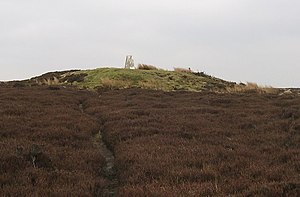Urra Moor: Difference between revisions
Created page with "{{Infobox hill |name=Urra Moor |range=North York Moors |county=Yorkshire |picture=Round Hill - geograph.org.uk - 12959.jpg |picture caption=Round Hill, the summit of Urra Moor..." |
|||
| (One intermediate revision by the same user not shown) | |||
| Line 1: | Line 1: | ||
{{Infobox hill | {{Infobox hill | ||
|name=Urra Moor | |name=Urra Moor | ||
|range= | |range=Cleveland Hills | ||
|county=Yorkshire | |county=Yorkshire | ||
|picture=Round Hill - geograph.org.uk - 12959.jpg | |picture=Round Hill - geograph.org.uk - 12959.jpg | ||
| Line 25: | Line 25: | ||
Probably the most striking relic is the Face Stone, a carved stone about three feet in height into which has been carved the shape of a face. | Probably the most striking relic is the Face Stone, a carved stone about three feet in height into which has been carved the shape of a face. | ||
[[Category:North York Moors]] | |||
[[Category:Yorkshire moors]] | [[Category:Yorkshire moors]] | ||
Latest revision as of 23:20, 26 August 2015
| Urra Moor | |||
| Yorkshire | |||
|---|---|---|---|
 Round Hill, the summit of Urra Moor | |||
| Range: | Cleveland Hills | ||
| Summit: | 1,490 feet NZ594015 54°24’20"N, 1°5’11"W | ||
Urra Moor is a moorland hill within the North York Moors, reaching 1,454 feet above sea level. It is the highest piece of moorland in the North York Moors National Park.
The name 'Urra Moor' is applied both to the moor as a whole and to the hill. The summit of the hill is also known as Round Hill.
Summit an ascent
The summit is crowned by a trig point, and a track passes about a hundred yards to the south of this point. This track forms part of the route of both the Lyke Wake Walk and the Cleveland Way, and is the most commonly used route of ascent for Urra Moor.
It is only two miles from the car park at Clay Bank to the summit on this route, with a total ascent of just 650 feet.
Ancient remains

Urra Moor is noted for its prehistoric remains. There are a number of barrows, and several carved rocks, including some cup and ring carvings.
Probably the most striking relic is the Face Stone, a carved stone about three feet in height into which has been carved the shape of a face.